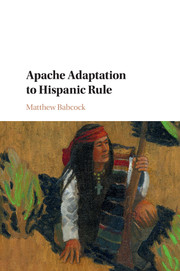1 - Peace and War
Published online by Cambridge University Press: 05 September 2016
Summary
More than a century and a half before Spanish officers tried to turn semisedentary Apaches into reservation-dwelling farmers, Franciscan missionaries conducted a similar experiment by attempting to convert them into town-dwelling Catholics. The deerskin-clad members of “the great Apache nation” live “in tents and villages (rancherías)” surrounding the Rio Grande pueblos of New Mexico “on all sides,” reported Friar Alonso de Benavides in 1630. Like hundreds of other European observers, Benavides noted that Ndé men were “very valiant in battle” and frequently moved “from one mountain ridge to another, looking for game.” But he also occasionally challenged this narrow vision. “Each main village has its own recognized territory in which they plant maize and other kinds of grain,” he revealed, and “they take great pride in telling the truth.” Since Ndé people already were self-sufficient and possessed strong moral values, taming the alleged belligerency of their young men was apparently the best justification Benavides could come up with for Catholicizing them.
Contrary to popular belief, many Ndé groups responded favorably to Franciscan conversion efforts. The powerful Chihene nantan Sanaba, who governed “the province of the Xila Apaches,” enthusiastically embraced the Catholic faith. From a pueblo situated fourteen leagues west of the Rio Grande Piro pueblo of San Antonio de Senecú, Sanaba reigned over the extensive Chi'laa (“land of the red paint people”), which encompassed modern southwestern New Mexico (see Map 1.1). A regular attendee at Benavides's weekly mass in Senecú, Sanaba also personally preached and converted his own people, making Benavides's job uncharacteristically easy. Before Benavides could visit Sanaba's people himself, the Chihene leader instead came to see Benavides and presented him with a rolled deerskin. After spreading it out, the priest observed a green sun above a dark gray moon, each surmounted by a cross (see Figure 1.1). Puzzled, Benavides asked Sanaba to explain the painting, and the Chihene headman stated, “I have ordered the cross painted over the sun and over the moon” to symbolize our understanding of your teaching “us that God is the Lord, and creator of the sun and moon and of all things.” Although Sanaba's explanation makes perfect sense, it is also important to remember that he and his people continued to revere the sun and moon, which the artist made the most prominent and brightly painted shapes on the deerskin, as important sources of spiritual power.
- Type
- Chapter
- Information
- Apache Adaptation to Hispanic Rule , pp. 19 - 60Publisher: Cambridge University PressPrint publication year: 2016

